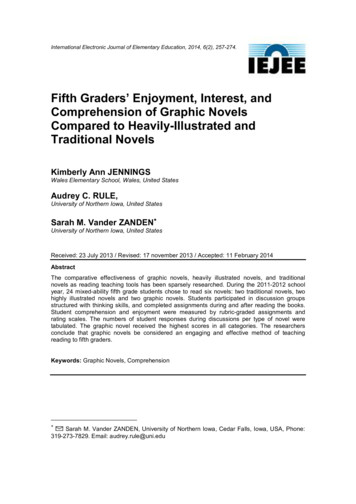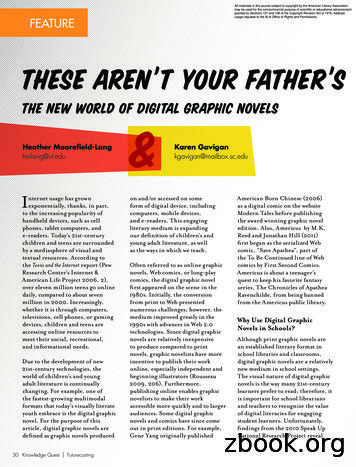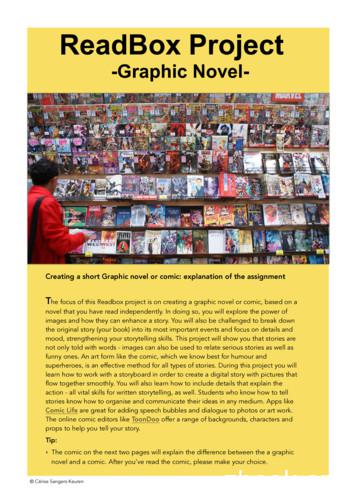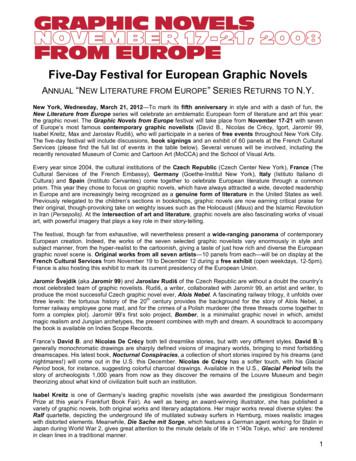Writing Graphic Novels
Writing Graphic NovelsJunior Writing Lessons and Worksheets
INTRODUCTIONWe decided to develop a course on graphic novel writing in order to capitalize on the popularity ofgraphic novels among junior-aged students. We found that any good writing program must incorporatea reading program as well. And so, these lessons include a book report assignment, a readingportfolio log and management tools as well as several lessons where the teacher and the classcooperate to interpret a popular children's novel into a graphic novel.Graphic NovelsGraphic novels are a relatively new phenomenon. It has really been in the last ten years that teachersand librarians are realizing the lure of graphic novels to elementary school students and theirusefulness in the classroom.It could be argued that “graphics” were the original form of reading. Early cave drawing show animalsthat were hunted in prehistoric times. Since then, art historians will tell us that the visual has been auniversal tool for depicting messages across cultures.In the last ten years, the publication of graphic novels has created a whole new genre. These booksare similar to the comic books of a generation ago. They are generally longer, book-length works thatcenter on a huge range of books – rewritten classics to non-fiction depictions of new global issues inscience and social studies.Graphic novels are important because they provide reading material that motivates students. Theauthors created an extended silent reading program for students and many students enjoyed thegraphic novels offered so much that they gave up recesses to complete the reading.It’s About Time2
What does a graphic novel look like and what is its appeal? Essentially, graphic novelstories are told in a format called “sequential art: the combination of text, panels, and images”which requires the reader to read text and analyze images to interpret the story (Brenner, 2006, p.123). Graphic novel readers have learned to understand print, but can also decode facial and bodyexpressions, the symbolic meanings of certain images and postures, metaphors and similes, andother social and literary nuances teenagers are mastering as they move from childhood to maturity.Graphic novels offer visual clues along with narration to tell a story. They are filled with figurativelanguage. Reading idioms, onomatopoeia, metaphors and similes in context helps students becomeaware of the true meaning of such phrases. Graphic novels can also help improve readingdevelopment for students struggling with language acquisition, as the illustrations provide contextualclues to the meaning of the narrative. When graphic novels are made available to young people, evenclassified as “poor readers” willingly and enthusiastically gravitate towards these books. Providingstudents with diverse reading materials, including graphic novels, can help them become lifelongreaders.A word of caution must be noted. Some graphic novels contain adult language and content. Librariansand teachers would be wise to rely on graphic novels by trusted publishers, like scholastic, and thosereviewed by colleagues in journals such as the Library Journal.How to Use these Lessons and WorksheetsAs classroom teachers ourselves, we decided that scripted lesson plans are cumbersome and needinterpretation in order to be used in the classroom. We decided to give short teacher instruction thatdeal with the purpose of the lesson and general overviews on how lessons should be delivered. Theauthors believe this format provides information and resources to classroom teachers but still allowsteachers to use their own styles to deliver the lessons. It is also mindful that teachers are continuallymonitoring and adjusting their lessons to suit the needs of their students.We also organized the lessons under ten headings. The lessons included in this unit are complete.We recognize that classroom teachers will choose which lessons (any or all) suit their needs. Weorganized the lessons under ten heading in order to make the teacher's perusal of the lessons easier.Please find the worksheets after the lessons. We organized this for ease of use as well. Teachers maychoose to use the lessons and worksheets as prescribed or may choose to pick among theworksheets in order to meet their own agendas.Graphic Novels ClubsWe created a graphic novel club in our school in addition to the teaching of graphic novels taught inclass. We wanted to meet the interests of students as well as addressing some of the extendedlessons found here. All lessons have been student-tested.A Note on Technology:We used Comic Life, Bitstrips and Xtranormal.com for technological interpretations of graphic novels.We found that due to limited computer access, this was best completed in the after school graphicnovel club.It’s About Time3
Why Should Teachers Use Reading and Writing of Graphic Novels in the Classroom: Deal with the difficult events/themes common to academic environments.They facilitate the introduction of abstract topics (power struggle, political change). Theseabstract topics help to maximize ‘intellectual time’ in the basic writing classroom.They illustrate how narrative can be built and how characters can be presented.More readily prompt discussions.Critical thinking takes place in the classroom and on paper.Students are not reliant on one interpretation of the story— they can read images and/or text.Discussions can engage potentially more students.There is more sense of the class group as a community because no one is at a disadvantagein the process –some have ‘read’ the pictures, some the text.Help teach students to ‘read’ the world, and reading allows students to verbalize their ideas.Graphic novels can be used as a writing tool in pre-writing.Students can use the comic book/storyboard approach themselves.They’ll know that no one can possibly describe everything. They have to (and can) leave someinterpretation to the audienceLessonPurposeOutline of lesson1Getting startedIntroduce graphic novelsallow students to peruse several graphic novelsReading Graphic Novels2Reading GraphicNovelsSet up a Friday Graphic Novels Reading ProgramWe used classroom and school library books plus graphic novels borrowedfrom the public library for this program.Motivation for reading these books was so strong that we sometimesextended the silent reading period to 45 minutes.3Graphic NovelsReading PortfolioSee attached form to review the reading portfolio program set up in eachclassroom.4Assign book reportWe provided a number of graphic novels (from our own collections, theschool library and the public library) and had students read them andcomplete simple book reports.Handout attached.The purpose of this lesson is to have the students become familiar withgraphic novels and to have them use one graphic novel as a model tobase their own on.5Present book reportsHave students present their book reports .During the presentations, keep a tally of different action words used,number of characters and the way setting was depicted (shown notdescribed)It’s About Time4
Analyzing the Text6Review the tallyinformation gatheredAs a class review the data collected and come to some generalizationsabout graphic novelsExamples:Setting was referred to with a few words: “ New York City”, “lunchroom”,“the next day”. Setting was mostly provided for in visuals.Conversation was the main form of text writing.Most fiction was in narrative form. Generally, the use of a single narrator oran omniscient narrator was about equally prevalent.Post these in the class for students to refer to when writing their owngraphic novel.7 and 8Analyzing student useofNarrative WritingGraphic Novels (fictional) demand narrative writing be more “alive” thanwhat we regularly see from students narratives.Have students write a short story describing their first day of school.Collect the narratives and read them for action-packed writing only.Create a list of writing problems that this form of writing takes on in yourclassroom (either with the students or without.).Much of the narrative writing that students produce is characterised by aflat, lifeless style that lacks reader appeal and offers little satisfaction to thewriter.The type of problems prevalent in student writing may be:1. We don’t SEE the character(s), the action or the setting. ‘Word pictures’ arelacking.2. Conversation is either absent of limited and/or unnatural.3. Character feelings are not shown. We don’t see the character as a real person.4. There is no plot. The main character does not have a problem. There are noplot hooks.5. The writer’s voice is absent. The writing is timid and reserved, making the styleuninteresting.6. Titles, lead sentences and character names are uninviting.7. There are gaps in the story. Necessary details are missing. They’re in thechild’s head.8. There are no surprises. There is no cheekiness, no fun.9. Sentences are too long. There are too many ‘and thens’.10. Story ending is flat, often finishing with a sentence such as ‘And then I wokeup.’It’s About Time5
9 and 10Using the analysis ofstudent writing toinspire better use ofnarrativesDiscuss the need to create a list of traits that good narrative writing has –the teacher may choose to read aloud selections from the students' work,her own classroom library or other material.Have students generate ideas about narratives they like.Possible ListWord PicturesWord pictures SHOW us the character, the action, the setting. The writerneeds to write in pictures, so the reader can SEE the story. ‘Show me –don’t tell me’ is the motto for word pictures.ConversationConversation should bring life to the character giving it. Again do notdescribe the character’s trait, show them.Character FeelingsFind stories which don’t show feelings and discuss how the characters arelikely to be feeling. Even one feeling in a story is powerful11 and 12 Provide aChecklist/rubric to helpstudent groups editstories from lesson 8In lesson 8 students wrote a short narrative on their first day of school. Thepast five lessons have been gathering information and experience on goodnarrative writing. Have students work in groups on a selected set of criteriato edit their original narrative.We didn’t provide a rubric here, as we found that student generatedchecklists driven by the work completed in previous lessons is the best fitfor improving this writing situation.Mechanics and Form of Graphic NovelsTitles, Lead Sentences, Character Names13 and 14 The Mechanics ofStory Writing: choosing Titlesa title, a character· Encourage children to choose a title after they have finished their firstname and leading intodraft. Suggest – a word, a question, a phrase from the story, anactionambiguous title.Lead Sentences· Ask students to find lead sentences they like and share them with theclass, saying why they are effective.· Discuss the use of various lead sentences in writing. Did thesesentences interest the student? Why?· Suggest students avoid leads that are long descriptions, negativestatements or action that has nothing to do with the story. Startingwith action is always a better hook.Character Names· ·Encourage students to use made up names in their writing. They’llhave great fun doing this.15Action WritingUsing the worksheet attached show students how to revise a passivesentence into a more action filled sentence.The teacher can have the class work in groups to revise sentences so thatthe action is more prominent.It’s About Time6
16Transition termsMost students use terms such as “and then” or “next”In graphic novels, students will be using fewer words and so, must usewords more effectively.Teachers can put a sample piece of writing with many instances of “andthen” and have students generate better transition words (just then,immediately, before I knew it)Create a list of transition words to post in the classroom for student useafter students complete the attached worksheet.17Using words as actions Describe for students the need to use efficient language in graphic novels.(Recall the information from the book reports completed earlier).Allow the students to work in team to come up with a list of at least tenaction words.Compile the words in a larger class list and post in the classroom forUsing a Read-Aloud Novel or Short Story to Model Graphic Novel Writing18 -25Model a graphic novel Using the book Junie B Jones Graduates by Barbara Park.reinterpretation of ashort story or fairy tale. The teacher reads the novel aloud and writes a short three sentencesummary of each chapter.The teacher draws a working sketch of Junie B Jones (retelling the story ismore important at this point than creating good art work – that comes later)The teacher and the class decide what to throw out from the original novel(not every incident needs to be repeated or explained to the same length inthis new text format)The teacher introduces story boards to the studentsThe mechanics of Drawing the Graphic Novel26draftStart by penciling the entire page. Draw lightly and erase with a gooderaser. Be as sketchy or precise as you want. You should pencil in the textfor each panel as well.27InkingOnce you're happy with the penciling, begin the inking phase. Use agood black pen or marker. Have different tips for different line widths. Analternative method is brush and ink, which is more challenging, butenables a different style. Good use of inking can make your drawingsseem dimensional and bold.28Making sense of thespacingProvide a sheet of clear overhead paper for this activity.Students can use trial and error to see what fits onto their paper beforewriting on the final copy.Note: large writing is better for graphic novels. The reader does not want tostruggle with being able to read the word because of size or legibility. Ifusing computer software, remember simple fonts are best.It’s About Time7
29Putting summaries toworkUse the summaries written from the class reading of Junie B Jones toreview whether important elements of the story have been met.Have groups meet to read the summaries and brain storm ways ofdepicting the action.Have groups present to the class and create a class list of strategies todepict action for a graphic novel.30Storyboards31Modeling how toreinterpret a novel for agraphic novelproductionStoryboards: storyboards are drafts of the graphic novel.For our purposes, there are few words on the storyboards. We are lookingto create an overall picture of the action of the graphic novel. We wish todirect the writing in later lessons. For now, the class created chaptersummaries and the storyboards are our goal.The author/illustrator gets a sense of how many panels she/he will needand can spend time arranging and rearranging his panels.Note: we had the students use larger photocopy paper (11 X 14)32Present story boardsHave students present their story boards to the class.Have the class write on sticky notes, comments and suggestions.When the presentation is finished, the presenting student will have severalsticky notes to read and consider.33Making changes to the Students can make changes to their storyboards by cutting out the panelsstory boardthey wish to keep.Students should then work on individual panels where changes can bemade.The panels can then be glued to a new sheet of paper for a completedstory board.34Students write theirown story boardsComic frames are traditionally used to illustrate a story in a short, conciseformat. In this lesson, students use a six-paneled comic strip frame tocreate a story map, summarizing a book or story that they've read. Eachpanel retells a particular detail or explains a literary element (such assetting or character) from the story.35Using words asillustrationsReview some online resources to see how certain words can be anillustration of the events. “POW” from the batman TV serial is an example.DialogueOne of the most important things to get right in a graphic novel is itsdialogue. It is through dialogue that you give life to your characters andthrough dialogue that tell your story.Dialogue36Use a newspaper to find several short comic strips.Photocopy the comic or strips (you’ll want at least a few pages — a wholeIt’s About Time8
comic’s worth would be useful) and blank out all the text, captions as wellas speech bubbles.Have students practice using only dialogue to make sense of the picturesin the comic strips provided.Note: Re-write the dialogue as if the characters were students' owncreations. Don’t try to use the characters as created by the writer, butpretend they are entirely different people. Try to give each character his orher own way of speaking — given enough dialogue students should beable to tell which character is which just by what they say. Students mayhave to be careful about exaggerating the differences between characters’speech at first; the differences should mostly be subtle.Note: this task grew out of weekly writing assignment borrowed fromanother teacher. She assigned a Far Side cartoon without the captionweekly to the students. Their task was to write a funny caption for thedrawing and also explain their reasoning for writing that caption.37Dialogue presentations Have students post re-written comics on the wall and mingle to read otherstudents' work.Discuss:Notice how the visuals of the comic effect any possible interpretations ofwhat is happening. Did you find it difficult to make up new text? Thinkabout what this means for text without pictures (short stories and novels).How can you create visuals using text only? What might gestures andactions interspersed with dialogue add to the meaning of the dialogueand/or to the progression of the story?38Writing dialogueHave students write a conversation using only dialogue. Have otherstudents guess where and when the conversation is taking place.Inferencing: students read between the lines to figure out what ishappening.A graphic novel leaves a lot of the action to be interpreted by the reader.So do not spoon-feed your readers with too much screenplay.Figurative Language39Quick descriptionsMetaphors and Similes:Discuss:1. What are some ways authors write to make their details more vivid?2. What are some good describing words to describe a (list something)?3. How can we write things to show comparisons?40Metaphors and Similes In graphic novels, using metaphors and similes especially in narration,helps to keep the action moving and portray setting, character's frame ofmind and description.It’s About Time9
Simile:"an explicit likening of one thing to another" (Chamber's TwentiethCentury Dictionary )Metaphor:"a figure of speech by which a thing is spoken of as being that which isonly resembles, as when a ferocious man is called a tiger" ( Chamber'sTwentieth Century Dictionary )Step 1 -- In a column on the left, place the first half of well known similesand metaphors with an answer place and question number before them(i.e. " 1. Happy as .")Step 2 -- In a column on the right, place the second halves of the similesand metaphors with answer letters in front of them in a random order (i.e. - A. "a clam")41Creating newDiscuss the use of image language such as metaphors and similes withmetaphors and similes students. Now that they have experience with the definitions and purposesof metaphors and similes, students should have more to say on this topic.Many metaphors and similes have lost their impact because they areoverly familiar to us. Creating new ones is the goal of this exercise.Teachers can create their own metaphors and similes with the class or usethe list below to examine the impact of this visual language.Directions: Identify each as a metaphor or simile. Then, explain themeaning.Her hair was golden silk streaming in the afternoon breezeThe algebra question x 16 30 is a sharp object jiggling around in my brainJordan walked like an monkey on paradeJan’s broken nose swelled up like a big red clown noseTim was as tall as the CN TowerCarr
Graphic novel readers have learned to understand print, but can also decode facial and body expressions, the symbolic meanings of certain images and postures, metaphors and similes, and other social and literary nuances teenagers are mastering as they move from childhood to maturity. Graphic novels offer visual clues along with narration to tell a story. They are filled with figurative .
The comparative effectiveness of graphic novels, heavily illustrated novels, and traditional novels as reading teaching tools has been sparsely researched. During the 2011-2012 school year, 24 mixed-ability fifth grade students chose to read six novels: two traditional novels, two highly illustrated novels and two graphic novels.
series, The Chronicles of Apathea Ravenchilde, from being banned from the Americus public library. Why use Digital graphic novels in schools? Although print graphic novels are an established literary format in school libraries and classrooms, digital graphic novels are a relatively new medium in school settings. The visual nature of digital graphic novels is the way many 21st-century learners .
literary novels, including but not limited to deep explorations of character, setting, theme, and plot. The key is for readers to look for each element of story in both the words and the artwork in graphic novels. 4. Familiar Genres—Graphic novels can be found in all the genres typically found in tra-ditional literature.
at the graphic novel rubric in order to know you know what your teacher expects from you. Before you begin creating your own graphic novel/ comic, have a look at some samples of graphic novels / comics. Step four: Create a first draft for your own graphic novel/ comic and gather or sketch images. Now that you had a look at other graphic novels and comics, you may already have formed an idea .
1 Five-Day Festival for European Graphic Novels ANNUAL “N EW LITERATURE FROM EUROPE ” SERIES RETURNS TO N.Y. New York, Wednesday, March 21, 2012 —To mark its fifth anniversary in style and with a dash of fun, the New Literature from Europe series will celebrate an emblematic European form of literature and art this year: the graphic novel. The Graphic Novels from Europe festival will .
not included graphic adaptations of novels. All texts here are original works designed specifically as graphic novels. If you are interested – check out some approved graphic versions of classic texts (Frankenstein, Beowulf
graphic novels and manga is a style of writing called fanfiction, where readers create and post their own alternative versions of stories featuring their favorite characters (e.g., Chandler-Olcott & Mahar, 2003). Why Use Graphic Novels in Social Studies? Graphic novels are amazingly diverse, both in terms of their content and usefulness.
Graphic Organizer 8 Table: Pyramid 8 Graphic Organizer 9 Fishbone Diagram 9 Graphic Organizer 10 Horizontal Time Line 10 Graphic Organizer 11 Vertical Time Line 11 Graphic Organizer 12 Problem-Solution Chart 12 Graphic Organizer 13 Cause-Effect Chart 13 Graphic Organizer 14 Cause-Effect Chart 14























